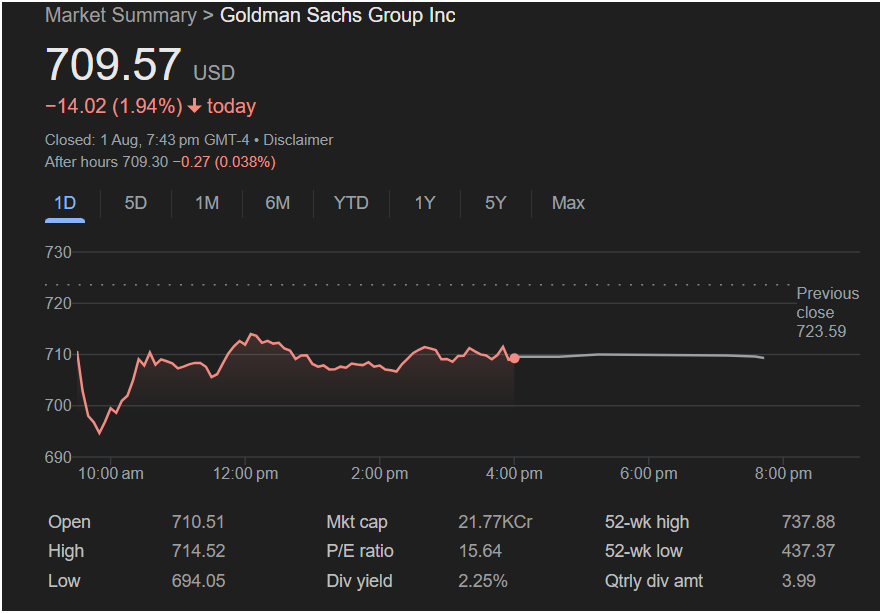Goldman Sachs Stock Slides as Market Awaits Catalyst Despite Strong Fundamentals

NEW YORK, NY – August 1, 2025 — Shares of Goldman Sachs Group Inc. (NYSE: GS) edged lower in Friday’s trading session, closing down 1.94% at $709.57, despite a backdrop of robust earnings and ongoing institutional strength. The move adds complexity to the stock’s recent trajectory as investors weigh macroeconomic uncertainty against the firm’s solid fundamentals.
Goldman’s shares fluctuated during the session, touching an intraday low of $694.05 and peaking at $714.52 before settling just shy of the $710 mark. In after-hours trading, the stock recovered slightly, gaining $0.27 (0.038%) to trade at $709.30.[1]
 The dip comes even as Goldman continues to outperform both the U.S. Capital Markets industry and the broader S&P 500 on a 12-month basis. The stock has climbed 39.4% over the last year, significantly outpacing major indexes and peers in the investment banking space.[2]
The dip comes even as Goldman continues to outperform both the U.S. Capital Markets industry and the broader S&P 500 on a 12-month basis. The stock has climbed 39.4% over the last year, significantly outpacing major indexes and peers in the investment banking space.[2]
Still a Powerhouse in Global Finance
Goldman Sachs remains a dominant player in global banking, trading, asset management, and advisory services. The bank recently posted strong Q2 2025 earnings, with net revenues of $14.58 billion and earnings per share of $10.91, beating consensus estimates on both top and bottom lines.[7][8]
Growth was primarily fueled by a resurgence in institutional client services, increased M&A advisory activity, and stronger-than-expected performance in the trading division.[5][8] The Asset & Wealth Management arm also continues to be a key revenue driver, benefiting from both organic inflows and favorable market dynamics.[9]
In addition, Goldman declared a third-quarter dividend of $4.00 per share, marking its 13th consecutive year of dividend growth — a signal of confidence in future earnings and balance sheet strength.[1][10]
Mixed Analyst Outlooks as Valuation Stirs Debate
Analyst sentiment around Goldman Sachs remains generally constructive, but not without caution. The stock holds a “Moderate Buy” consensus across major brokerages, with an average 12-month price target of $660 — slightly below current levels — suggesting concerns over short-term valuation.[3][4][6]
Targets range broadly from $560 on the low end to $790 on the high end, indicating a divergence in expectations. Some analysts argue that the stock has priced in much of its current momentum, while others believe that upside remains underappreciated, especially if market volatility persists and trading revenues stay elevated.[3][6]
Goldman’s forward P/E ratio remains below the industry average, making it comparatively attractive for value-oriented investors. Still, ongoing concerns about the macro environment — particularly Fed policy, market liquidity, and geopolitical risk — may be keeping a ceiling on the stock’s near-term potential.
Macroeconomic Headwinds and Tailwinds in Focus
While the financial giant’s earnings outlook remains robust, broader macroeconomic factors are playing a key role in investor sentiment. Among them:
- Federal Reserve policy: Hints of possible rate cuts later this year could enhance trading activity and credit issuance, both of which favor investment banks like Goldman Sachs.[11][12]
- IPO market rebound: A revival in tech and fintech IPOs could feed Goldman’s investment banking pipeline in the second half of 2025, bolstering advisory fees.[13]
- Global M&A trends: Improving cross-border deal flow and corporate consolidation could further elevate revenue, assuming market conditions stabilize.
Still, risks persist. Economic softening could weigh on loan demand, raise credit costs, and compress margins, particularly if clients take a more conservative stance.[9] Meanwhile, the firm continues to face regulatory scrutiny around AI governance and digitization of financial services — issues that may carry both compliance and reputational risks if not managed proactively.[13]
Looking Ahead to Q3 Earnings and Strategic Guidance
With Goldman Sachs set to report Q3 2025 earnings on or around October 21, investor focus will turn toward forward guidance, particularly regarding:
- Capital market activity pipeline
- Global fixed income performance
- AI and fintech initiatives
- Expense discipline and efficiency ratios
The company’s ability to sustain its revenue trajectory while navigating regulatory challenges and macro shifts could determine whether the stock breaks above its 52-week high of $737.88 or continues to oscillate within current ranges.
Would you like this formatted for financial newsletters, media syndication, or expanded into a long-form investment deep dive (e.g., 10,000 words) covering:
- Historical performance vs. JPMorgan, Morgan Stanley, Citi
- Segment breakdown: trading, asset management, investment banking
- Goldman’s private credit, PE, and digital finance ambitions
- Risk exposures and stress test analysis
- Shareholder structure and institutional ownership trends
- Detailed valuation metrics and financial modeling
Let me know how you’d like to tailor the next version.




